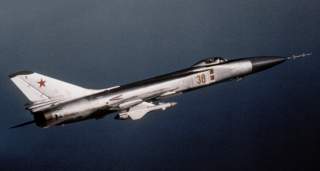A Russian Fighter Plane’s Tragic Error Brought Us Google Maps
The 1983 Korean Air Lines shootdown spurred Ronald Reagan to share GPS.
Larsson snapped several photos of the shadowing aircraft, which flew under the call sign Yellow 36. Then he returned to base for refueling.
On his second sortie that day, the same two Flagons returned. One of the Soviet fighters crowded in close to his wingtip, making it difficult for Larsson to record his images. The Swedish pilot attempted a series of tight turns and twists to shake off the interceptor, but it doggedly remained within 50 meters of his Viggen’s wingtip.
Annoyed, Larsson finally executed an extremely tight half-roll at around 400 miles per hour while only 500 meters above the Baltic.
The agile Viggen fighter is famous for its canards—a second small pair of wings alongside the nose—which grant it superb maneuverability. The Su-15, by contrast, was clumsy at low-altitude. Larsson’s Viggen managed to pull out of the roll just 100 meters over the water.
His pursuer attempted to copy his maneuver—and stalled, smashing into the sea and exploding in a ball of fire.
Realizing his mission had gone terribly wrong, Larsson belted for home. The Su-15’s wingman came barreling toward him as if seeking revenge. Skimming just 50 meters over the water, Larsson hit the afterburner and broke the sound barrier, not an easy speed to maintain at low altitude where the air density is high.
The Su-15 fell behind him and locked its missiles on Larsson’s fighter—but then abruptly peeled away for home as two additional Viggens soared into the suddenly tense Baltic airspace. For next several months, Soviet and Swedish pilots scrupulously maintained their distance from one another.
The deceased Sukhoi pilot was one Capt. S. Zhigulyov of the 54th Guards Fighter Regiment based in Vainode, Latvia. Soviet ships searched for the pilot for two days without success. The remains of his flight jacket washed ashore a decade later. He was one of the many “non-combat” casualties suffered by both sides of the Cold War in countless games of cat-and-mouse.
Despite the Sukhoi Su-15’s elegantly clean design and good high speed performance, it had the misfortune of being designed for a high-altitude interception mission that was becoming outdated by advances in tactics and technology by the time it entered service.
Russia retired its last 320 Su-15TMs shortly after the collapse of the Soviet Union as part of the force reductions mandated by the Treaty on Conventional Armed Forces in Europe. A small number remained in Ukrainian service until 1996.
The aerial sentries of the Soviet Union had seen their last flight, but not before leaving a surprisingly large mark on world history—if not exactly one its designers had intended.
This first appeared in WarIsBoring here.

